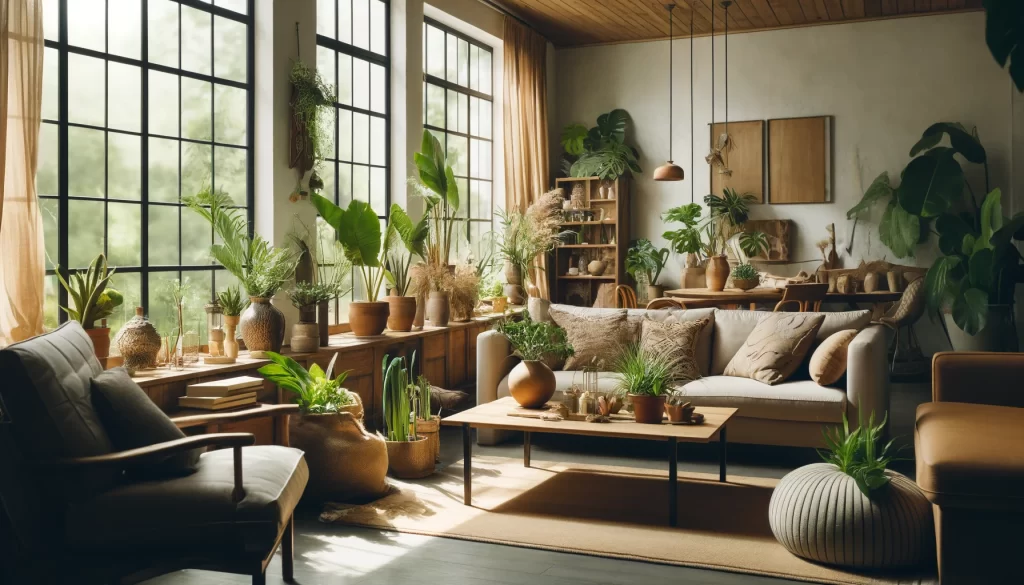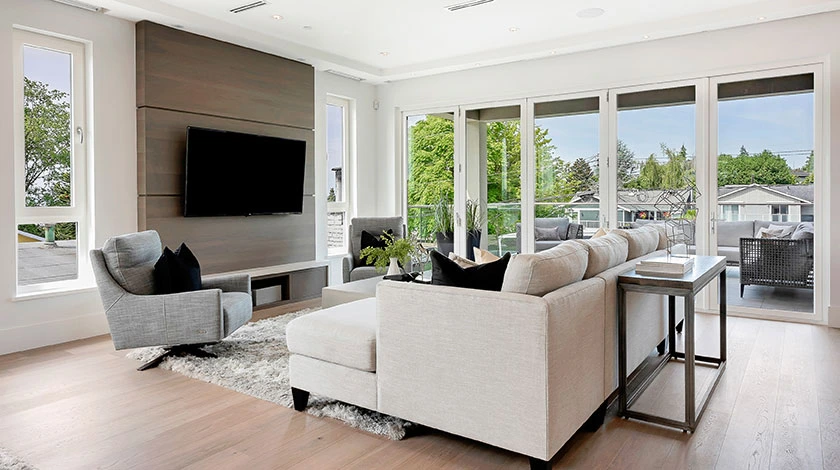Over the past decade, open-concept living has become one of the most desirable features in modern home design. It’s praised for creating a sense of spaciousness, enhancing natural light, and promoting a more social and connected lifestyle. Whether you’re renovating your current home or designing a new one, you’ve likely considered the benefits of knocking down a few walls.
Open-concept living represents a shift in how we view the purpose and flow of our homes. Rather than dividing spaces into isolated rooms, it aims to encourage more dynamic interaction between areas. It blends functionality with aesthetics, creating a harmonious environment for modern lifestyles.
It also supports the demands of contemporary living—where multitasking, social connection, and accessibility are more important than ever. As kitchens, dining rooms, and family spaces begin to overlap in both purpose and layout, open-concept living reflects the reality of how we live today.
But is open-concept living the right choice for everyone? While the idea of flowing, wall-free interiors can be appealing, there are practical considerations to keep in mind. In this guide, we’ll explore what open-concept living really means, its advantages, potential drawbacks, and how to determine if it’s the right fit for your lifestyle and home layout.
Remodeling for openness also means adjusting how you use and experience your space. From the layout to lighting, flooring, and even acoustics, everything plays a role in making this concept successful. That’s why understanding the details before you begin is essential.
What Is Open-Concept Living?
Open-concept living refers to a home layout where traditional barriers like walls and doors are minimized to create a more fluid space. Typically, it combines the kitchen, dining, and living areas into one large open room. This trend has grown in popularity across all types of homes—from suburban houses to urban condos—because of the versatility and brightness it offers.
An open layout is not just about tearing down walls; it’s about creating intentional spaces that flow seamlessly together. With the right design elements—like consistent flooring, coordinated color schemes, and multifunctional furniture—open spaces can be both beautiful and functional.
This approach to design allows for more flexible furniture placement and can make small homes feel much larger. It’s also adaptable for different styles, whether modern, farmhouse, or minimalist. However, successful implementation requires thoughtful design choices and clear visual boundaries to avoid the space feeling too vast or chaotic.
Benefits of Open-Concept Living
1. Enhanced Natural Light
Without walls to block light, open-concept layouts allow natural sunlight to flood your interior spaces. This makes rooms feel larger, more welcoming, and energizing.
Natural light is known to boost mood and reduce energy bills by decreasing the need for artificial lighting during the day. If your home feels dark or enclosed, an open-concept design may be the perfect way to brighten things up.
Open layouts also allow you to make better use of windows and glass doors. Light that once served only one room can now illuminate several areas. It creates a continuous glow that uplifts the entire space and improves your home’s overall atmosphere.
2. Better for Entertaining and Family Time
One of the most appealing aspects of open-concept living is how it fosters interaction. When the kitchen, dining, and living areas are integrated, it’s easier to entertain guests or spend time with family while cooking or relaxing.
Parents can supervise children while preparing meals, and hosts can mingle with guests without being isolated in the kitchen. The layout also offers flexible space for larger gatherings, making your home more event-friendly.
Conversations and activities flow more naturally in an open-concept space. You won’t feel disconnected from your loved ones while doing chores or working on dinner, and this connection promotes a greater sense of togetherness throughout the home.
3. Modern, Spacious Feel
Open-concept layouts tend to feel more modern and updated. By removing visual barriers, your home appears larger and more expansive—even if the square footage hasn’t changed. This can be particularly beneficial in smaller homes or older properties where compartmentalized rooms create a cramped atmosphere.
The airy feel of open-concept living appeals to many buyers, making it a strong selling point if you ever decide to put your home on the market.
Additionally, open layouts are more adaptable for today’s evolving lifestyle needs. They accommodate multitasking, working from home, and blended family dynamics more effectively than traditional layouts.
Challenges of Open-Concept Living
1. Lack of Privacy
While open spaces promote connection, they also reduce privacy. Without walls, it can be harder to find quiet or separate areas for work, study, or relaxation.
If your household includes remote workers, students, or multiple generations, the absence of private zones may become a drawback. Acoustic issues—such as sound carrying from the kitchen to the living room—can also be problematic in open layouts.
You may need to explore noise-dampening design elements like area rugs, curtains, or acoustic ceiling panels to balance openness with functionality. In some homes, partial dividers like bookcases or glass panels are used to reclaim a bit of separation without completely enclosing a space.
2. Limited Wall Space and Storage
Fewer walls mean fewer surfaces for artwork, shelving, and storage. Built-ins and creative furniture solutions can help, but it’s important to plan ahead if you have a lot of belongings or want to display decorative pieces.
You’ll also need to consider how to organize and “zone” the space without traditional walls. Area rugs, lighting, and furniture arrangements become essential tools in defining each section of your open area.
Here are two practical solutions to improve storage in open spaces:
- Use vertical storage solutions: Tall cabinets and wall-mounted shelving help make up for lost wall space.These options utilize height efficiently and can double as decorative elements.
- Invest in multifunctional furniture: Pieces that provide storage, such as ottomans or benches, are ideal.They help reduce clutter while preserving a streamlined look in your open layout.
3. Heating, Cooling, and Noise Control
Heating and cooling large open spaces can be less efficient than managing individual rooms. Airflow must be well-balanced, and HVAC systems may need to be upgraded for comfort and efficiency.
Similarly, sound can travel easily through open areas. Without walls and doors to buffer noise, you may notice echoes or have trouble containing sound between different activities.
Strategic HVAC planning and thoughtful soundproofing are essential in open spaces. Zoned climate control systems or ductless mini-splits can offer better temperature management. Sound-absorbing materials like cork flooring or acoustic panels can also help minimize unwanted noise.
Is Open-Concept Living Right for You?
Choosing an open-concept layout comes down to your lifestyle, needs, and personal preferences. Ask yourself:
- Do you enjoy hosting and want a more social layout?If entertaining is a priority, open layouts provide the perfect stage.
- Are you comfortable with less visual and acoustic privacy?
Consider daily routines and how noise levels may affect household members. - Do you need separate spaces for work, study, or relaxation?
Think about whether a hybrid design might better serve your needs. - Can your current structure accommodate an open layout safely?
A professional contractor can help assess if your walls are load-bearing.
If you love natural light, connectivity, and a modern vibe, open-concept living might be ideal. However, if your household has varying routines or you value private space, a semi-open or traditional layout could be a better fit.
Assessing your family’s daily habits, noise tolerance, and need for organization can offer clarity. Remember that open-concept doesn’t have to mean “one big room”—partial openings and visual connections can offer a great middle ground.
Tips for a Successful Open-Concept Renovation
Planning to transform your home into an open-concept space? Consider these tips:
- Consult a structural engineer to ensure safety before removing any walls.
Professional evaluations prevent costly and dangerous errors later. - Define zones with lighting and furniture to give each area a unique function.
Creating visual boundaries maintains structure in your open design.
The more thoughtful your design choices, the more successful your open-concept space will be. Working with an experienced designer or remodeler ensures the layout functions as well as it looks., the more successful your open-concept space will be. Working with an experienced designer or remodeler ensures the layout functions as well as it looks.
Timeline Remodeling – Your Open-Concept Living Experts in NJ
At Timeline Remodeling, we specialize in home renovations that reflect your lifestyle and goals. Whether you’re dreaming of a wide-open living area or a kitchen that seamlessly connects to your dining room, we can help you design and build the perfect open-concept space.
With over 25 years of experience in New Jersey, our team combines structural expertise with creative design to ensure your remodel is beautiful, functional, and safe. From the initial consultation to the finishing touches, we’ll work with you every step of the way.
Our remodeling approach is personalized and results-driven. We listen carefully to your vision and offer guidance to help you get the most out of your space. Whether it’s removing a wall, optimizing layout, or blending style with practicality, we bring your dream space to life.
Contact Us Today
Ready to explore the possibilities of open-concept living? Reach out to Timeline Remodeling and take the first step toward a more connected and contemporary home.
📞 Phone: (732)-322-3827
📧 Email: timelineremodelingllc@gmail.com
🌐 Website: timelineremodeling.com
Let us help you navigate the design, construction, and finishing process for your open-concept remodel. With expert advice, craftsmanship, and care, we’re your trusted NJ remodeling partner.



